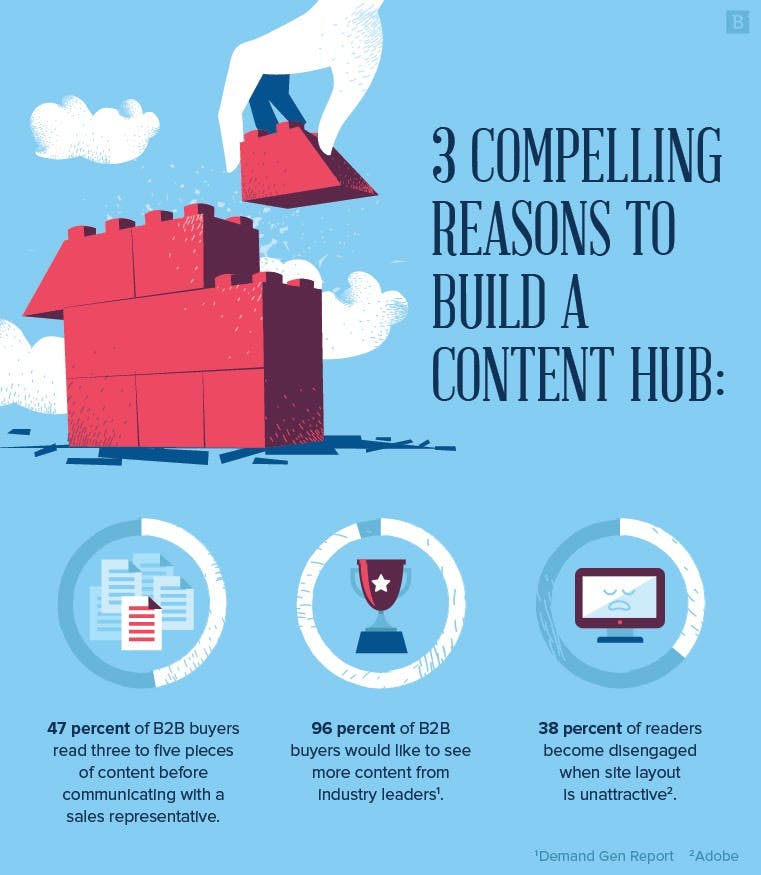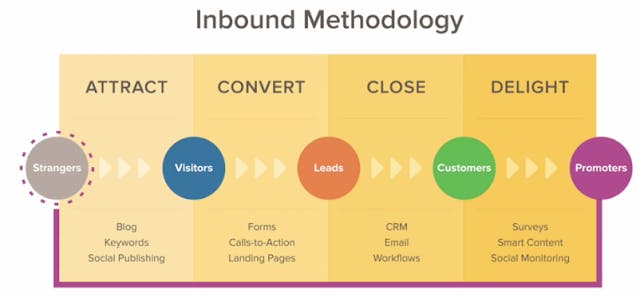What is AIDA model: steps, approaches and examples
Oct 13th, 2021

When interacting with the target audience and visualizing the customer’s journey, the marketers use the sales funnel. This tool combines the analysis of consumer motivation, mindset, behavioral patterns, and the required messaging and techniques to capture and retain customers’ attention and motivate them to make purchases.
The sales and marketing funnel is a complex process represented as a model with the widest point narrowing to the bottom. The visitors pass through research, education, information, and decision-making phases before making the final choice. Each stage of the funnel is aligned with unique advertising strategies, marketing channels, and messages.
What is AIDA model?
AIDA model is a classical marketing framework that is used for designing sales and marketing communication strategies. According to the model, the customers go through four stages before buying the product or service. These steps are reflected in the name of the model: Attention, Interest, Desire, and Action. In some modern adaptations, Attention is replaced by Awareness.

With the help of the model, the brands can create the appropriate tactics for conveying the marketing messages to the target audiences. The AIDA model shows high efficiency using psychological techniques related to cognitive, affective, and behavioral components. The structure of the model is similar to the sales funnel, where the customers perform the desired actions in a certain phase. In addition, fewer potential customers remain at each stage in comparison to the previous one.
The first version of the AIDA model appeared in 1898 when Elias St. Elmo Lewis, American advertising and sales pioneer, described the formula of successful advertising. The advertising advocate mentioned the three principles that he identified for himself while working in The Inland Printer, one of the most popular journals of the nineteenth century.
Lewis stated: “The mission of an advertisement is to attract a reader, so that he will look at the advertisement and start to read it; then to interest him, so that he will continue to read it; then to convince him, so that when he has read it he will believe it. If an advertisement contains these three qualities of success, it is a successful advertisement.”
The three principles formed the basis of the AIDA, one of the best-known marketing models today. In the next section, we will explain the four steps of the model in greater detail.
Four steps of the AIDA model
When the customers pass through the model stages, you want them to experience a range of emotions related to your product or service that encourage them to take action and complete a purchase. So let us analyze how you can implement the AIDA model to improve your marketing strategy and guide the customers towards the buying decision.
Step 1. Secure attention
At the first stage, the consumer learns about the brand, product, or service through advertising. The primary purpose of the step is to build brand awareness about the offer and grab the customers’ attention. Unfortunately, this stage of the marketing funnel is often undervalued and underfunded. However, this part is crucial for success. Before you can get people interested in your product, you need to raise awareness and provide valuable content through effective messaging.
Approaches and tools. Content marketing is the best way to attract customers’ attention. Focus on generating informational content that addresses their problems and interests and delivers the solution. The next step is to promote the content to your target audience through social media platforms, podcasts, search engine optimization, pay-per-click advertising, digital PR, and other marketing channels and methods.
You can use exciting, provoking, or shocking elements to draw attention to your content. For example, a compelling headline, personalized ad, or intriguing visual will make your customers continue to learn more about your product and brand.
An excellent way to structure the content and target different people is a content hub. A content hub is a website, blog, or page where you can publish the materials dedicated to the specific topic to increase traffic and drive leads. The main benefit of the content hub is the opportunity for the customers to find relevant content in a convenient format. Creating engaging content that attracts users’ attention and engages them will encourage the customers to learn more about your business, product, or service.

Example of attention stage implementation. Airbnb created the content hub called Airbnb’s Neighborhoods Guide, which allows the visitors to find suitable locations depending on their interests and the local lifestyle of the residents in the preferred parts of the city. Each city on the website’s list is subdivided into specific neighborhoods. With this intuitive interface, the customers can easily find more information and recommendations about the exact places they plan to visit.
Step 2. Evoke interest
Once the customers are already aware of your brand, product, or service, it is time to arouse their interest. At this stage, you need to demonstrate your product’s benefits and unique characteristics and earn the customers’ trust. The central purpose of the step is to engage the visitors with your content and deliver the marketing message in the appropriate way that will suit the needs of the target audience. The key to success is to have a clear understanding of the customer requirements, get them actively involved, answer the questions that arise at this stage, and show how the product will improve their lives.
Approaches and tools. Now you need to provide the reasons to purchase your product, so the content should align with the visitors’ values. To stimulate your prospects’ interest, use storytelling, include facts, and address pain points. Provide the content which educates and helps customers solve their problems, such as e-books and webinars, or one-pagers in case of in-person conversations. Entertaining content that demonstrates your expertise, such as blog posts and articles on social media, can also help you maintain their attention. The use of humor, provocative headlines, and images will be effective for holding customers’ interest. Newsletters and email campaigns are the other useful methods to keep the target audience engaged.
Example of interest stage implementation. Hubspot is a beautiful example of a company that created an innovative method to hold consumers’ interest through inbound product marketing. Hubspot makes a lot of valuable content, so the consumers perceive the company’s website as a helpful resource regardless of their intention to purchase something. The brand offers informative and detailed guides, e-books, video tutorials, marketing kits, blog posts, and webinars. The high-quality content is free, engaging, and relevant. This is a secret of Hubspot’s high rankings in Google and its ability to become a multibillion-dollar company in 15 years since its inception.

Step 3. Stimulate desire
The next stage of the AIDA model is to turn the customers’ interest into desire. In most cases, the consumers reach this stage when they compare the products or services from different brands. So, the goal of this step is to create an emotional connection to your offer. You also need to explain the unique characteristics and benefits to your target audience, adding to the information about your product that the customers already know. Other ways to stimulate desire are to provide sales or discounts, demonstrate your product as a solution to certain problems and create scarcity with countdown timers.
Approaches and tools. To increase the chances of buying your product or service, you need to motivate consumers to interact with your brand as often as possible through effective lead nurturing practices. A nice way to maintain contact with your customers is to get them to subscribe to your email and send them relevant content regularly. You can develop desire by leveraging user-generated content, “before and after” case studies, reviews, and testimonials. The best channels for distributing these types of content are social media platforms and blogs.
Example of desire stage implementation. Samsung teamed with K-pop girl group Blackpink to promote the #danceAwesomeJo hashtag challenge before the debut of the Galaxy A smartphone. Then the company encouraged people to submit unique social content about the future product. The marketing campaign with user-generated videos was extremely successful and gained more than 20.5 billion views.
Step 4. Initiate action
When the customers already have enough information about your brand, product, or service, you need to motivate them to take action. Summarize the problem you are going to address and how your product would solve that issue. You can apply your call to action at this stage, encouraging the customers to visit your website, joining a mailing list, or making an order. The processes related to the Action stage, such as checkout, should be simple and convenient. In the other case, you can lose the customer.
Approaches and tools. Your CTA messaging should be well-written and visually appealing to demonstrate what action the customers need to perform and what they will receive as a result. You can add the CTA button in the emails or place it on the website. Call to action can be in the form of scheduling a demo, requesting a discount, or registering for a free trial. A perfect call to action should explain what value customers get, use persuasive language, clarify any possible doubts and evoke a sense of urgency.

Providing a variety of simple payment options is as important as the convenience of the overall checkout interface. For example, if your audience widely uses Paypal or Apple products, providing a way to pay through these services might considerably improve the conversion.
Example of action stage implementation. Amazon created Pay EMI to encourage customers to buy products. As a result, the company’s clients can receive credit costs which they can utilize to complete high-value purchases on the online marketplace even when they have a limited budget.
Examples of the AIDA model in practice
Let us consider a few more examples of the well-known brands that put the AIDA model into practice.
Netflix
- Attention. The company uses Youtube ads, display ads, and collaborations with Internet Service providers to make the users aware of their offers.
- Interest. Once the user visits the company’s website, Netflix provides a free monthly trial to allow visitors to test the product’s characteristics and explore the range of TV shows available on the platform.
- Desire. With the number of various features, such as the support of low-speed devices, high-quality content without ads, the ability to download videos, and personalized recommendations, Netflix creates the desire to subscribe to the company’s services.
- Action. Netflix turns the visitors into paying customers by offering a wide choice of subscription plans and the ability to cancel anytime.
Buffer
- Attention. The SaaS marketing company is an official Facebook Marketing Partner. Buffer also attracts users through partnerships with Twitter, WordPress, Zapier, Pocket, and Feedly.
- Interest. In 2017 the company launched the podcast “The Science of Social Media”, where it describes best practices and ideas from social media marketing professionals.
- Desire. Buffer creates a desire by providing the ability to solve customer problems. The service simplifies the publishing process and allows to conduct deeper social media analysis in one place.
- Action. The page with the CTA button contains the statement that more than 75,000+ businesses are using Buffer to drive engagement on social. It builds trust and persuades the user to purchase the product.
So, as you can see, the AIDA model is an effective strategy for planning business and marketing decisions. Content strategists find it useful for designing the marketing funnel and for understanding the customer decision-making process. Following the simple formula with four components — attention, interest, desire, and action — gives you a clear and concise way to transform potential into paying customers. Now that you’re aware of the whole process, it’s time to take action!
